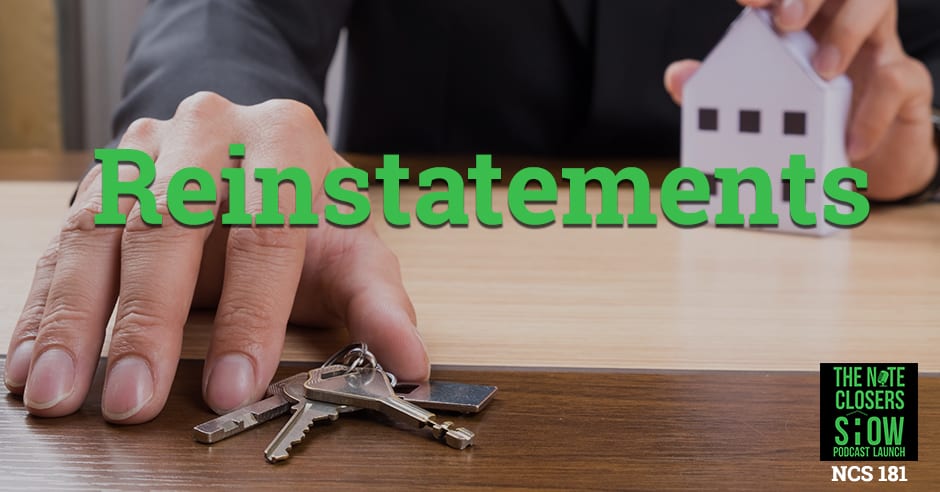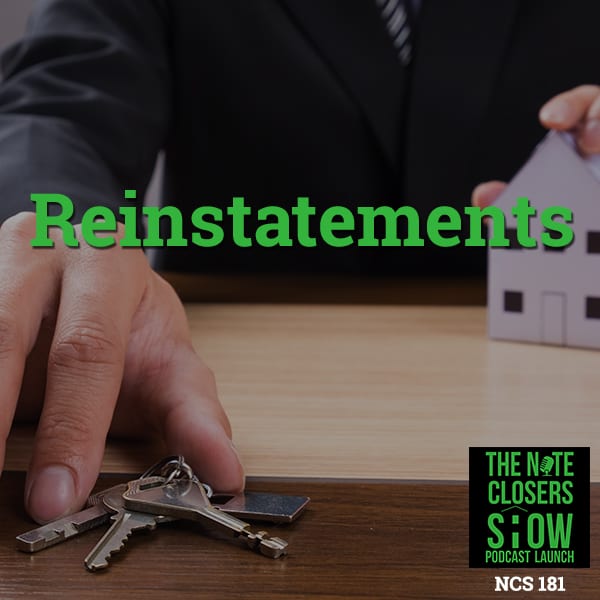 Scott discusses reinstatements; why getting a borrower to reinstate a loan is one of the most profitable ways to make money in note investing..
Scott discusses reinstatements; why getting a borrower to reinstate a loan is one of the most profitable ways to make money in note investing..
—
Listen to the podcast here
Reinstatements

Reinstatements: Wholesaling is one of the easiest ways without needing your own money and your capital.
Today, we want to discuss with you our next topic on how to make money in notes. We’ve been going through a little bit almost every day about a different aspect of note investing. Today’s topic is all about reinstating. What do you do to get the borrower to reinstate? How is that and why is that the most profitable way in note investing? Wholesaling is one of the easiest ways without needing your own money and your capital. Options are one of the cheapest ways to secure stuff that you can wholesale off and move things into profits into your IRAs by using a $10 or $100 option fees. Reinstating is something that’s big. That is really the first question that you’re going to see when you’re dealing with your servicers, you’re going to be dealing with your special asset managers like The Law Offices of Daniel Singer.
If you like this, you can pull out your cell phone and you can text the word NIGHT to the phone number 72-000. It will send you a link to get registered for the webinars and you’ll be permanent register. All you got to do is basically register for the webinar once and you’ll be given invites to it on a regular basis every Monday night so you don’t miss out. It helps people get connected without really missing anything. All our replays to the Monday Notes are on Vimeo.com/WeCloseNotes.
Let’s talk about reinstatement. I’m going to share my experience as a deadbeat borrower. There was a period I was out of college about three years, graduated in 2001 and roughly the later part of 2003 to early 2004 was a bit of a financial struggle. I’ve been laid off, was starting again making ends meet and was behind our mortgage. We got a couple of investment properties that were not going well. The only people making money on those investment properties was the actually realtor that sold us the property because we bought them at full value, 80/20 mortgages. When you lose your job making six figures and you’re living off a private school teacher’s salary at $30,000 a year, trying to pay three firsts and three seconds, one in your primary and two on investments, it doesn’t go very far.
I was a deadbeat borrower. When I talk with borrowers, I empathize with that. It’s not a fun time. When you get that every day, you’re stretched and you’re scared when the postal service person knocks on your door to hand you a certified letter and you get to know them on a regular basis, that’s not a cool thing. It’s a very scary, stressful aspect of it. When you’re talking to your special servicers and your servicers are reaching out, that should be one of their first questions when they’re talking to the borrowers, when they’re making the right party contact with them, “Do you want to stay or do you want to go? Can you start paying your existing payment on time?” That should be questions one and two, “Do you want to stay? Can you start paying your existing payment?” That will go a long way.
To reinstate, I always like to have the borrower bring some skin in the game. One thing you have to realize is if you flip it from the opposite side like what the banks will do. When a person goes late in their mortgage and the person may be trying to send them half a payment, the banks won’t accept that. Oftentimes, the banks will just put that half a payment into an escrow account. Then once the borrower really does go late, they’re going to send it back because they don’t want to accept that half payment. If they’re going to accept it and cash that check, it stops to default. It keeps them from being able to go back and start with the foreclosure process based on what they’re behind on.
Oftentimes, you’ve got to realize if the banks does accept the cash and deposits it, then they can’t really start the foreclosure process because they accepted the payment. They’re virtually saying, “We understand you’re late. We’re going to go and accept the payment because we’re greedy bastards.” This is why you will often see banks and they’re talking to the borrowers and say, “No, we don’t want partial payments. We want the full amount. We want the full twelve months in payment. We want the full two years in payment. We want the full six months in payment that you’re behind on.”
We all know, 85% to 90% of America is one missed paycheck away from being in default because most people have no savings. They don’t have a lot of money saved up, especially if they’re out of work. They’re at a point where they’re having to decide, “Am I going to pay rent, my mortgage payment, or am I going to pay power? Am I going to feed my kids this week or this month or am I going to pay for our house?” It is not a decision that anybody wants to make. I’m a firm believer that 90% of most Americans want to pay their mortgage, they want to pay their rent on time, they want to stay in the property. Most people are good people, except for the weird lazy ass people that try to take advantage of the system or the crazies that we see.

Reinstatements: You have to realize that aspect of things that not all people are bad. Bad things happen to good people all the time.
You have to realize that aspect of things that not all people are bad. Bad things happen to good people all the time. I’ve gone through financial hiccups. I remember dealing with Countrywide, it was my lender at the time, of trying to negotiate with them because I was behind by about six months. They wanted a big chunk of money and I’m like, “I don’t have that. I can bring you this to the table and I can pay a couple of $100 extra.” Really just a forbearance agreement is what I needed. I didn’t need to modify the terms because I got back to working in six months’ timeframe where I was working in Hi Tech for a short period of time before I got back into banking.
When you’re talking to borrowers, you just got to listen what’s going on. Shit happens. It is what it is, so listening to the borrower. I know a lot of people are like, “I would like to listen on a phone call.” That’s not going to happen. Most of the time the servicer is not going to let you. That’s just not going to happen. What will happen is you often get a dialogue going via emails, you can log into the online portals and see the comments back and forth. Jen had seen that with Madison Management. You’ll realize that you’re going to see the chat roll, you’ll be able to see comments most of the time from the servicer on what’s going on with the borrower. That’s why asking for your servicing comments, if you can get it, is a really valuable aspect of your due diligence because you can see if the borrower corresponds, you can see if they communicated with the servicer.
A lot of times, after a while people are just embarrassed, I can understand that and they just quit opening their mouth. They just quit answering the phone because they realized the number that’s calling every month is their bank or their lender, and they don’t have an answer. If you can get them on the phone, it’s not to call them ugly names, it’s not to bash them down. It could very well be you if something were to happen to you. It’s to have a little empathy and talk with them. Before you promise them anything, a potential modification, always ask, “Can you start making the existing payments?” This is why it’s important as part of your due diligence to see what market rent is in the area. What’s the market rent for that same type of property they’re living in? I guarantee they have already have been looking. I guarantee when somebody goes more than three, four months behind, they’re going to start looking at what market rents are there because they know the other shoe is going to drop at some point. That’s a very valuable negotiation nugget. If their mortgage payment is less than rent, then that’s really no excuse not to reinstate, not to start paying on time. Start paying again.
If it’s the opposite where rent is less than their mortgage payment is, you’re going to have to almost automatically realize, “I’m going to have to modify my side from the banking side to keep them in the property. Otherwise, I’m going to end up having to foreclose and deal with a vacant house.” That’s okay but today’s topic is all about reinstating. What are some the things you do besides looking at rent? One big nugget is calling the utility department to see if the power is on, to see if the water’s turned on, if your realtor drive by the property. It’s important to identify those things so you don’t buy an ugly piece of crap. The house looks in good shape but stinks to high heaven. We don’t want to take the house.
If you can reach out to the utility departments and they give you a lot of information, “Yes, they were in here last week. They’re on a payment plan.” If somebody’s on a payment plan, that’s not a bad thing. It shows you that they’re being responsible. A lot of people won’t make the phone call to the utility departments to even try the payment plan. A lot of people won’t call the county for taxes to try to make a payment plan. They just shove their head in the sand and then they run and don’t do anything. Those are the worst situations to deal with because I can give some options but you’ve got to reach out to me, you’ve got to communicate with me.
The thing to keep in mind when you’re talking to people, you can see these things, they’re either trying to make a payment when the rent is higher than the payment. One of the things we like to do is see if they have made a payment in the last six to twelve months. If the borrower has made a payment in the last six to twelve months and they’ve been in the house for three years or four years or five years, that should tell you they probably want to stay. They probably just had a hiccup, out of work, laid off, sick, medical situation, guy or gal has gone through a divorce, had a baby. We’ve seen a lot of these things.
We do have a question, “What’s the best way to find out who the utility providers are?” We just basically Google the county water provider, because that’s not usually deregulated. We just see if it’s on, if the water account is inactive or active.
It’s not a hard thing to do. It’s literally just Googling who’s the county water provider, who’s the water company or the gas company that serves whatever it is.
On the house that we actually got the photos on, when I looked at the notes when we called the water department, they said it was on a septic. When we looked at the photos, you could tell it’s a real rural area.

Reinstatements: When you go to the electrical side, that’s the one thing that’s really deregulated.
That might be an idea not to look at septics anymore. I grew up on a septic tank. You start getting to septics, you’re a little bit outside of town for the most part. That’s not a bad thing. We’re checking power and water, unless they’re on a well. When you go to the electrical side, that’s the one thing that’s really deregulated. That’s the hardest aspect to find out. If there’s not sewer, there’s not water on, they’re probably not paying on time. I know I’ve walked into plenty of houses from doing short sales over the years where water was turned off. I’ve actually seen this on a few of our note deals where the borrower’s stealing water from their next-door neighbors, where they’ve literally got a water hose running from the next-door neighbors that they have buried it and ran it up the house through a window into the bathroom. I’ve seen that happen a couple of times. I’ve seen it where there was an exterior power supply or extension cord plugged into that trench, power cord buried, power cord runs up through a window into the kitchen or in the bedroom or somewhere.
It doesn’t mean people are bad, they’re just trying to find a way to survive. A reinstatement is going to be your best return on investment because they can start paying again. Being able to pay again and bring in a little bit extra to the table, three to four months of payments, you don’t need the full year or two years, but you can even bring something, they can start paying again. Let’s just say $0.50 of the unpaid balance. You’re paying that $0.50 of unpaid balance and their mortgage was at 6% interest rate or 5%, you instantly just doubled that ROI. If it’s at a 6% interest rate and you bought it at 50% unpaid balance, that’s easy, that’s 12% ROI. Now add in four months extra payments, that’s a pretty good return. That’s basically getting now an extra 33% of payments for the year on stock. Instead of going from a 6%, you’re now sitting there on a 14% to 16% ROI that first year if it’s just off of that loan.
Katie Moton shared something. They bought a house up the mortgage. It was basically going to be about a 30% ROI if they reinstated, because they bought it at roughly 33% of the unpaid balance. It was at a 9.9% interest rate. That calculates up to just under 30%. Then the borrower paid $5,000 down towards total back payments. $5,000 down on what they paid $15,000 for the note. Instantly, they’re going to get a 33% yield without payments coming in. That’s phenomenal and that’s a home run for them on that little deal. It’s an easy way to raise capital if you’re sharing the details of the deals as well on an on-going basis.
You’ll never know what people would do to reinstate. Some people will go with their 401(k) or retirement capital and cash those in to pay the arrearages or pay something. People will borrow money from friends and family. They’ll go sell off the big screen TVs or get rid of some of the toys and be serious about staying on time. After you’ve got six months or preferably twelve months of on-time payments, it becomes seasoned as a re-performing note and the value of that note goes up dramatically where you can sell it at roughly 80%, 85% of UPB. What you’re going to see re-performing notes sell at is roughly at 12% to 15% yield. You can sell a lot of re-performing notes off to IRA investors who want passive, performing note investors that don’t want to deal with any of the workouts, they just want passive returns to come in.
What you do is, to calculate what kind of payment you would get on a re-performing note, take the twelve months of payments, and just take the twelve months. I won’t put anything extra in there because usually your extras are all going to come in the first year. Take twelve months of payments and divide that by the interest rate that you’re looking to sell. Let’s say their payment is $500 a month, times twelve is $6,000. If I want to sell it at 12% interest rate to somebody for performance, divide it by.012, that means I can sell that note at $50,000. The thing to keep in mind, if the unpaid balance is less than $50,000, I’m not going to sell it at $50,000. I’m never going to sell a note over what’s owed.
Another thing, I’m never going to sell a performing note directly at the par. I’m going to leave a little bit of room in there in case it does go in default, that there is a room for the buyer to be able to have a little flexibility. Let’s just say 85% of $50,000, multiply it by 0.85, so I would sell that note at $42,500. If I take the $6,000 cashflow and divide it by $42,500, which is 85% of the $50,000, that’s a 14.1% ROI. That’s great because I left the end buyer who’s buying my re-performing note $7,500 to foreclose or to work on it. He’s also made some re-appreciation of the assets or maybe a little equity above it. That’s the way that reinstating a loan becomes valuable, not only on the frontend but very profitable on the backend.
The one thing you’ve got to keep in mind is looking at that mortgage and make sure it hasn’t modified down ridiculously low. Now we see a lot of interest rates that’s a 2% interest.
We have a question, “Do you see a lot of extra payments for back payments around tax time as compared to other times?”
I’m going to actually ask Jen to talk about this because I think you’ve got a few borrowers mention that as well about bringing an extra to the table around tax time.
Yes. We’ve had a couple that basically said that they can maintain their payments and some their refund was coming, and we had one that turned around and did a triple payment.
You said it happens a lot of times. Don’t count on it especially if you’re six months out from tax season. Most people that are pay check to pay check, and there’s nothing wrong with that, will take their last pay stub the end of the year and go file it, especially the first week of February when they issue their W2s or whatever. Oftentimes they can get a refund check there if they do it at H&R Block or somewhere where it’s six weeks out. That’s a good thing to keep in mind. Middle of the year we don’t usually see tax checks coming in. This is a rare situation with three payments immediately, which we’ll take.
It’s hit or miss, or if you’re actually receiving the payments people say they’ll pay you. We’ve had a lot of people that we’ve made the initial agreement. We’re waiting for them to make their first payments so we can actually do the modification. Those didn’t come through so everyone got little reminder emails saying, “It’s the end of the month, we didn’t receive your payment. We’re going to have to proceed with foreclosure eviction.” We’ll see how the responses go.

Reinstatements: Most rents are due by the fourth or fifth, or it’s late. People get paid either on Friday.
Most rents are due by the fourth or fifth, or it’s late. People get paid either on Friday. We’ve had a good chunk that paid, a good chunk of the people that we reach out to initially the last 90 days have paid, but they’re dragging their feet or they’re making partial payments, not making full payments. Those who don’t make full payments, we’ll be returning checks to them and say, “This isn’t what we agreed to. You’ve got to pay the full amount.
If the borrowers don’t make a payment, they don’t follow through on what they’re saying to get you reinstated, you need to get him on the phone. If someone calls me and say, “My pay check is a little late.” One way is like, “I can make a double payment.” I go, “You get paid every two weeks?” “Yes.” “Why don’t you make a payment every two weeks so it’s not such a huge burden on you on the first of the month? Make your normal payment, make your catch-up payment, the second pay check.” That was much more, “I could do that?” As long as it’s coming in and it comes directly to you.
We always want a payment that go to a loan servicing company. We’ve got a few of our borrowers sending payments directly to basically try to endorse us right back to Madison to make sure we’re not collecting or violating anything. Plus it makes it a whole lot easier instead of us saying, “So and so sent in $1,000. We’re going to go and keep that $1,000 check.” It’s not the best way to do it. It’s not how it works. We had a large check coming from the previous seller which we’ve got to basically forward over to Madison with the outline of what accounts it goes into, what escrow accounts, what extra payments went where. It was not the easiest thing to decipher but we’re working through that.
Reinstatement is a great thing. A lot of people want to stay and people want to make their payments on time. You have to realize that going in. Give them an opportunity. I’m always glad to give a borrower an opportunity. If they don’t follow through what they tell me, I don’t run a charity. That’s why it’s important to take it to a special servicer. Get your servicing company to start taking the actions to take that property back. For every month that a person is in the house and you’re not doing something, they’re literally stealing from you.
Nobody’s going to invest with you if you don’t take the right steps to make things happen. Reinstatement is your friend. Reinstatement is a great aspect of things. Do not make the mistake of not working with your borrowers. If you’ve got a borrower who wants to make a payment, work with them. The biggest mistake that I made early on was not wanting to reinstate, wanting to foreclose everything. Your reinstatements, your modifications, if you figure out the yield on things and having cashflow coming in versus not having to wait around and having just cashflow going out in attorney fees, foreclosure cost, and fix and flips, not a fun thing.
We have two questions. First, “If their payments are already quite low, under $400 to $500 range, reinstatement sure seems best as I remember you were mentioning before. It’s just very little wiggle room for a modification, right?”
That’s correct. If they’re paying $400 to $500 a month, they’re may be some wiggle room. It just depends on what you paid for the note. That’s why you’ve got to know what your ROI calculation is going to tell you, what you paid, what you’re looking for yield, and what’s your ultimate goal. If their payments are less than $500 a month and rents $1000, sometimes it may be better to have a discussion to discuss Cash for Keys or deed in lieu. Sometimes, “Mr. and Mrs. Borrower, I’d love to keep you in the property but market rent is $1000 and your mortgage payment is $500. If you can’t pay that, honestly I would love to keep you in, but I can’t. I can’t afford to.” There are rare circumstances like extreme elderly, handicapped, past and present military, we will make some exceptions for that so I’m not being a totally heartless bastard here. What I’m trying to say is it’s got to be a really extraneous or special case for us to want to really go below that.
Second question is, “How long do you wait to start the foreclosure?”
Thirty days, because you can only suspend the foreclosure. Starting it is always the most integral key of it. You can always go back and suspend it or delay it, but that’s holding the feet of the borrower to the fire. If you want to start the fire, there’s no real forcing that borrower. The borrower stayed in that property for a year, two years, three years, four years, they’ve never had anybody hold their feet to the fire, that’s what you’ve got to do. You’ve got to start that timeline. You’ve got to start that foreclosure process or at least get the attorneys involved because oftentimes a letter from an attorney goes up and the borrower’s like, “Oh, shit.” Sometimes we had deals that we thought we were going to foreclose, the borrower showed up at the very end, “I’ll reinstate. I’ll pay off. I can now do this, I’m working again.” I’ll work with them. There have also been plenty of cases where we thought they would be reinstated and that they still want to pay. They didn’t show up so we had to foreclose. If we waited longer and longer to foreclose, it will only hurt us in the long run. It’s our money we’re putting out or our investor’s money we’re putting out. You have an obligation to treat that money well. In states where there’s longer foreclosure process, you better start that really fast.
We have another question, “Do you wait to get the loan transferred?”
Do I wait to get the loan transferred before I do the modification or foreclosure? You’re going to have to wait for the loan to get transferred from the seller servicer to your servicer before starting foreclosure. You have to wait for the servicing transfer to take place before you can start the foreclosure process because it’s just sitting in limbo. The thing you can do, this is why it’s important to have a special servicer like The Law Offices of Daniel Singer and Polaris, where they’re reaching out to the borrowers ahead of time and getting the right party to contact in finding out if the borrower is going to tell you to F-off or they’re going to hustle. By the time that the 30 days roll by and the servicing takes place, then you know. I’m not going to mess with them, just go and start foreclosure, “They told us to F-off, attorney had sent a letter, let’s get this thing started.”
I think about how much the street will improve for the neighborhoods when people move in and they can afford the upkeep cost of ownership above the P&I payment.

Reinstatements: This is why a reinstatement is so much better, even a modification is so much better than foreclosure.
Foreclosures do affect every market. This is why a reinstatement is so much better, even a modification is so much better than foreclosure. I was at the Quest IRA Boot Camp. Just about every speaker there, except myself, Quincy Long, and Tom Perry from the Houston REIA that he runs there, was talking about going and getting assets and dealing with distressed borrowers from the flood or dealing with foreclosure statistics. The thing I wanted to say is that’s the beautiful thing about notes. We get them reinstated and modified and we’re buying on a smaller level, and I mean smaller level not like Bank of America is doing with a ton of stuff or anything like that. We’re buying stuff that never hits the foreclosure auction or never hits less than six to twelve months, an effective way to not negatively affect that neighborhood. For every foreclosure that hits that neighborhood, it’s going to depreciate the value to probably $10,000, $15,000, sometimes $20,000, sometimes $30,000 in value. If you’re in a domino phase where there’s foreclosure, foreclosure, foreclosure, your value is dropping the faster. I’ve actually been on the wrong end of this about a foreclosure here in Austin. It was worth $300,000 when I bought it. Six months later, it was worth $180,000 because foreclosures devastated that market. It was dropping at $10,000 and by the time I was trying to get out of that thing, it was worth $180,000 and I was into it for more than that.
That’s why reinstatement is so great. It keeps the values up. It can help borrowers keep that pride of ownership. Deed in lieu, Cash for Keys, it keeps the foreclosure off the MLS records, and then you can sell it as an REO and hopefully boost the values up rather than depreciate the values.
We have another question, “My understanding is that the first step of foreclosure is a demand notice. Once the borrower receives this, they have thirty days to respond. Therefore, the foreclosure doesn’t really start automatically. The perfect time to find out about the borrower’s story at work in reinstatement or modification. Do you agree?”
That is correct. The first thing that we really send out is a demand letter. That’s what kicks it off, demand letter is sent. You’ll see that in the notes. Most of the notes will tell you that’s behind the foreclosure, the demand letter has been sent. They basically have thirty days to respond and then you’re filing stuff and going from there. That’s always going to be the first domino that kicks everything off, make sure the demand letter is sent. The longer you wait for that, the longer and lower your ROI gets.
Once again, I want to thank you for joining us on this episode of The Note Closer’s Show. I have to give a big shout out to our sponsors, Laughlin Associates, Quest IRA, just a few of our amazing cash investors that do such a great job. You can catch the replay by going to Vimeo.com/WeCloseNotes for all of our video replays. We’ve got over 1,000 videos on there. Go out and make something happen. We’ll see you all at the top.
Important Links
- The Law Offices of Daniel Singer
- Madison Management
- H&R Block
- Polaris
- Quest IRA Boot Camp
- Quincy Long
- Tom Perry
- MLS
- Laughlin Associates
- Quest IRA

